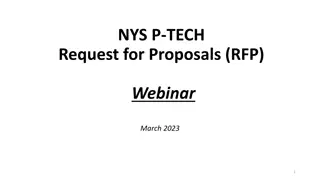
Ham Radio Technician Class Exam Preparation by Rich Bugarin W6EC
Get ready for your Ham Radio Technician Class exam with tips on reading questions, study hints, and information on signals and emissions. Explore topics like modulation modes, bandwidth, and emission types. Created by Rich Bugarin W6EC for effective exam preparation.
Uploaded on | 0 Views
Download Presentation

Please find below an Image/Link to download the presentation.
The content on the website is provided AS IS for your information and personal use only. It may not be sold, licensed, or shared on other websites without obtaining consent from the author. If you encounter any issues during the download, it is possible that the publisher has removed the file from their server.
You are allowed to download the files provided on this website for personal or commercial use, subject to the condition that they are used lawfully. All files are the property of their respective owners.
The content on the website is provided AS IS for your information and personal use only. It may not be sold, licensed, or shared on other websites without obtaining consent from the author.
E N D
Presentation Transcript
Hi-Landers Ham Class Instructed by Rich Bugarin W6EC
Ham Radio Technician Class Exam preparation Power Point created by Rich Bugarin W6EC. Effective July 1, 2022 and is valid until June 30, 2026. Please send suggested changes to this presentation to: w6ec@thebugarins.com
Study Hints I suggest you read each question and only the correct answer. Read through the complete question pool at least three times before you attempt taking a practice exams. For higher impact and better results read the correct answer first then the question and again the correct answer. The key to passing the exam is to get the most questions correct using the above method the correct response will often jump out at you on test day even if you don t remember the question.
Text Color Black: Original/Official questions and information in original format (unaltered). Red: Original information text color simply changed to highlight subject. Blue: Notes and information added by Rich (W6EC).
SUBELEMENT T8 SIGNALS AND EMISSIONS [4 Exam Questions - 4 Groups]
T8A Basic characteristics of FM and SSB; Bandwidth of various modulation modes: CW, SSB, FM, fast-scan TV; Choice of emission type: selection of USB vs LSB, use of SSB for weak signal work, use of FM for VHF packet and repeaters #27 of 35
T8A01 Which of the following is a form of amplitude modulation? A. Spread spectrum B. Packet radio C. Single sideband D. Phase shift keying (PSK)
T8A01 Which of the following is a form of amplitude modulation? A. Spread spectrum B. Packet radio C. Single sideband D. Phase shift keying (PSK)
T8A02 What type of modulation is commonly used for VHF packet radio transmissions? A. FM or PM B. SSB C. AM D. PSK
T8A02 What type of modulation is commonly used for VHF packet radio transmissions? A. FM or PM B. SSB C. AM D. PSK
T8A03 Which type of voice mode is often used for long-distance (weak signal) contacts on the VHF and UHF bands? A. FM B. DRM C. SSB D. PM
T8A03 Which type of voice mode is often used for long-distance (weak signal) contacts on the VHF and UHF bands? A. FM B. DRM C. SSB D. PM
T8A04 Which type of modulation is commonly used for VHF and UHF voice repeaters? A. AM B. SSB C. PSK D. FM or PM
T8A04 Which type of modulation is commonly used for VHF and UHF voice repeaters? A. AM B. SSB C. PSK D. FM or PM
T8A05 Which of the following types of signal has the narrowest bandwidth? A. FM voice B. SSB voice C. CW D. Slow-scan TV
T8A05 Which of the following types of signal has the narrowest bandwidth? A. FM voice B. SSB voice C. CW D. Slow-scan TV
T8A06 Which sideband is normally used for 10 meter HF, VHF, and UHF single-sideband communications? A. Upper sideband B. Lower sideband C. Suppressed sideband D. Inverted sideband
T8A06 Which sideband is normally used for 10 meter HF, VHF, and UHF single-sideband communications? A. Upper sideband B. Lower sideband C. Suppressed sideband D. Inverted sideband
T8A07 What is a characteristic of single sideband (SSB) compared to FM? A. SSB signals are easier to tune in correctly B. SSB signals are less susceptible to interference C. SSB signals have narrower bandwidth D. All these choices are correct
T8A07 What is a characteristic of single sideband (SSB) compared to FM? A. SSB signals are easier to tune in correctly B. SSB signals are less susceptible to interference C. SSB signals have narrower bandwidth D. All these choices are correct
T8A08 What is the approximate bandwidth of a typical single sideband (SSB) voice signal? A. 1 kHz B. 3 kHz C. 6 kHz D. 15 kHz
T8A08 What is the approximate bandwidth of a typical single sideband (SSB) voice signal? A. 1 kHz B. 3 kHz C. 6 kHz D. 15 kHz
T8A09 What is the approximate bandwidth of a VHF repeater FM voice signal? A. Less than 500 Hz B. About 150 kHz C. Between 10 and 15 kHz D. Between 50 and 125 kHz
T8A09 What is the approximate bandwidth of a VHF repeater FM voice signal? A. Less than 500 Hz B. About 150 kHz C. Between 10 and 15 kHz D. Between 50 and 125 kHz VHF ham (2 Meter) uses narrow spacing of 12.5 KHz
T8A10 What is the approximate bandwidth of AM fast-scan TV transmissions? A. More than 10 MHz B. About 6 MHz C. About 3 MHz D. About 1 MHz
T8A10 What is the approximate bandwidth of AM fast-scan TV transmissions? A. More than 10 MHz B. About 6 MHz C. About 3 MHz D. About 1 MHz
T8A11 What is the approximate bandwidth required to transmit a CW signal? A. 2.4 kHz B. 150 Hz C. 1000 Hz D. 15 kHz
T8A11 What is the approximate bandwidth required to transmit a CW signal? A. 2.4 kHz B. 150 Hz C. 1000 Hz D. 15 kHz CW uses the least bandwidth of all transmission modes so pick small
T8A12 Which of the following is a disadvantage of FM compared with single sideband? A. Voice quality is poorer B. Only one signal can be received at a time C. FM signals are harder to tune D. All these choices are correct
T8A12 Which of the following is a disadvantage of FM compared with single sideband? A. Voice quality is poorer B. Only one signal can be received at a time C. FM signals are harder to tune D. All these choices are correct
T8B - Amateur satellite operation: Doppler shift, basic orbits, operating protocols, modulation mode selection, transmitter power considerations, telemetry and telecommand, satellite tracking programs, beacons, uplink and downlink mode definitions, spin fading, definition of LEO , setting uplink power #28 of 35
T8B01 What telemetry information is typically transmitted by satellite beacons? A. The signal strength of received signals B. Time of day accurate to plus or minus 1/10 second C. Health and status of the satellite D. All these choices are correct
T8B01 What telemetry information is typically transmitted by satellite beacons? A. The signal strength of received signals B. Time of day accurate to plus or minus 1/10 second C. Health and status of the satellite D. All these choices are correct
T8B02 What is the impact of using excessive effective radiated power on a satellite uplink? A. Possibility of commanding the satellite to an improper mode B. Blocking access by other users C. Overloading the satellite batteries D. Possibility of rebooting the satellite control computer
T8B02 What is the impact of using excessive effective radiated power on a satellite uplink? A. Possibility of commanding the satellite to an improper mode B. Blocking access by other users C. Overloading the satellite batteries D. Possibility of rebooting the satellite control computer
T8B03 Which of the following are provided by satellite tracking programs? A. Maps showing the real-time position of the satellite track over Earth B. The time, azimuth, and elevation of the start, maximum altitude, and end of a pass C. The apparent frequency of the satellite transmission, including effects of Doppler shift D. All these choices are correct
T8B03 Which of the following are provided by satellite tracking programs? A. Maps showing the real-time position of the satellite track over Earth B. The time, azimuth, and elevation of the start, maximum altitude, and end of a pass C. The apparent frequency of the satellite transmission, including effects of Doppler shift D. All these choices are correct
T8B04 What mode of transmission is commonly used by amateur radio satellites? A. SSB B. FM C. CW/data D. All these choices are correct
T8B04 What mode of transmission is commonly used by amateur radio satellites? A. SSB B. FM C. CW/data D. All these choices are correct
T8B05 What is a satellite beacon? A. The primary transmit antenna on the satellite B. An indicator light that shows where to point your antenna C. A reflective surface on the satellite D. A transmission from a satellite that contains status information
T8B05 What is a satellite beacon? A. The primary transmit antenna on the satellite B. An indicator light that shows where to point your antenna C. A reflective surface on the satellite D. A transmission from a satellite that contains status information
T8B06 Which of the following are inputs to a satellite tracking program? A. The satellite transmitted power B. The Keplerian elements C. The last observed time of zero Doppler shift D. All these choices are correct
T8B06 Which of the following are inputs to a satellite tracking program? A. The satellite transmitted power B. The Keplerian elements C. The last observed time of zero Doppler shift D. All these choices are correct
T8B07 What is Doppler shift in reference to satellite communications? A. A change in the satellite orbit B. A mode where the satellite receives signals on one band and transmits on another C. An observed change in signal frequency caused by relative motion between the satellite and Earth station D. A special digital communications mode for some satellites
T8B07 What is Doppler shift in reference to satellite communications? A. A change in the satellite orbit B. A mode where the satellite receives signals on one band and transmits on another C. An observed change in signal frequency caused by relative motion between the satellite and Earth station D. A special digital communications mode for some satellites
T8B08 What is meant by the statement that a satellite is operating in U/V mode? A. The satellite uplink is in the 15 meter band and the downlink is in the 10 meter band B. The satellite uplink is in the 70 centimeter band and the downlink is in the 2 meter band C. The satellite operates using ultraviolet frequencies D. The satellite frequencies are usually variable
T8B08 What is meant by the statement that a satellite is operating in U/V mode? A. The satellite uplink is in the 15 meter band and the downlink is in the 10 meter band B. The satellite uplink is in the 70 centimeter band and the downlink is in the 2 meter band C. The satellite operates using ultraviolet frequencies D. The satellite frequencies are usually variable
T8B09 What causes spin fading of satellite signals? A. Circular polarized noise interference radiated from the sun B. Rotation of the satellite and its antennas C. Doppler shift of the received signal D. Interfering signals within the satellite uplink band
T8B09 What causes spin fading of satellite signals? A. Circular polarized noise interference radiated from the sun B. Rotation of the satellite and its antennas C. Doppler shift of the received signal D. Interfering signals within the satellite uplink band






















